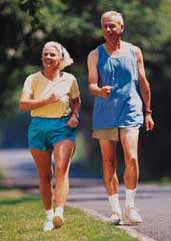Exercise and Weight Loss (continued)
Here are some tips for building muscle strength and endurance:
- Choose a weight you can lift about 8-15 times without your muscles getting too tired.
- Start with one set of lifts (a set is 8-15 lifts). Over time, build up to 2-3 sets. Rest 1-2 minutes between each set.
- Some people like to do circuit training. They do one set of each exercise and then repeat. This gives your muscles time to rest. For example: 1 set of arm curls, 1 set of leg curls, 1 set of bench presses. Then repeat the sequence.
- Strength exercises should focus on these areas: legs, arms, hips, shoulders, abdomen, back and chest.
- Give your muscles enough rest between workouts. Experts suggest at least 36-48 hours. In other words, only 2-3 times per week. If you want to exercise more often, work on one body area (upper body - arms and chest) one day and the other body area (lower body area - legs, back and abdomen) the next.
- Remember to breath when lifting and lowering the weights. People tend to hold their breath, which can elevate your blood pressure. So count out loud.
- Always move slowly and smoothly. Don't jerk or rush. Most people lift and lower weight to a count of 2 or 4. The longer it takes, the more you exercise your muscles.
If you don't want to use weights or go to a health club, there are other ways you can strengthen muscles.
- Crunches (the newer, safer sit-up), leg lifts, push-ups or hand weights can be used at home.
- Instead of buying weights when you first start out, use what you have at home. Be inventive. Try soup cans, glass or plastic bottles (like from Karo Syrup) that you can fill up with sand. Once you work up to a comfortable weight, then invest in a set of weights.
- Also, your local sporting good store may sell rubber tubes (or larger rubber bands) that are used to build muscles.
- Look for a video or guidebook that shows how to perform these exercises properly.
Be sure to check with your doctor before starting a strength-training program.
These are not safe for everyone.
 Exercise in the Golden Years Exercise in the Golden Years
Do you think you are too old for exercise? Think again. We are learning more and more about how good exercise is for older adults. Here are some ways it can help:
- Many people lose muscle mass as they age. This was thought to be a normal part of aging. Now experts believe the loss of muscle is from being less active. Exercise that includes strength training can keep you strong, flexible and fit as you age.
- Often people lose energy as they age. If you are fit, you will have more energy.
- Exercise is good therapy for many health problems older adults have. So, it can be said that exercise becomes more important as you age.
If you are an older adult, here are some tips for a safe exercise program.
- Talk to your doctor before starting. Ask for guidelines on safe exercise.
- Aim for at least 30 minutes most days. Start slowly and know your limits. If needed, exercise for 5-10 minutes a few times a day to build up your endurance.
- Drink plenty of water. This keeps your body from losing too much fluid.
Once You Start, Keep It Up!
Exercise helps you in many ways. It can improve your health, keep you fit and strong, help you lose weight and make you feel good. But once you stop, these perks start to fade. You may see your blood sugar creeping up after just a few days. After a few weeks the pounds you lost may start to return.
Once you start an exercise program, it can be hard to keep it going. You may need to push yourself a little every week to keep it up. You may even fall off the wagon and stop exercising. Instead of feeling like you have failed, just get started again.
Here are some tips to keep your exercise program on track:
- Choose an exercise that you enjoy. Make it something you look forward to.
- You don't need to feel pain to make a gain from exercise. Start slowly and work up to your exercise goals.
- Be patient. It may take a few months for you to notice progress with weight loss or improved strength.
- Find an exercise buddy. Support is often needed to stick with it.
 Continue Continue 
|





